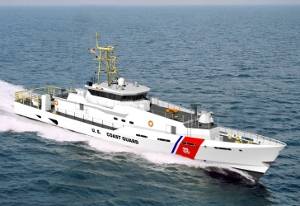Cathelco Protects New USCG Cutters
A series of fast response cutters being built for the U.S. Coast Guard will be protected against hull corrosion and marine pipework bio-fouling with a system manufactured by Cathelco Ltd.
The Sentinel Class cutters, measuring 154 ft in length and capable of speeds of more than 28 knots, are being constructed at the Bollinger Shipyard’s facility in Lockport, La. The order for the Cathelco equipment has been won by Russ Equipment Co. Inc., Cathelco’s agent based in New Orleans.
Cathelco will be supplying impressed current cathodic protection (ICCP) systems to protect the steel hulls of the cutters against corrosion. They will also be supplying marine pipework anti-fouling (AF) systems to protect the vessels’ seawater cooling lines against blockages caused by barnacles and mussels.
“One of the priorities in the design was to reduce the weight and size of the equipment. The Cathelco modular control panel is a single unit serving both the ICCP and AF systems. It is already lightweight in design, but in this case we have carried out modifications which produce even greater weight savings using slim-line modules”, said Stephen Ellis, Engineering and R&D manager, at Cathelco’s headquarters in Chesterfield, United Kingdom
The ICCP system will consist of two elliptical anodes and two reference electrodes mounted on the hull surface, port and starboard, wired to a single control panel. In operation, the reference electrodes measure the electrical potential at the seawater/hull interface and send a signal back to the control panel which raises or lowers the output to the anodes, ensuring the optimum level of corrosion protection at all times.
“High speed vessels can be vulnerable to hull corrosion because the speed of the craft generates greater turbulence and higher aeration at the stern as the propeller spins”, said Ellis.
As part of the ICCP protection package, Cathelco will be supplying a shaft earthing system. Shaft earthing is a vital component in the protection of all vessels, especially high speed craft. The purpose of a shaft earthing system is to provide a return path for the relatively small, but nevertheless significant amounts of corrosion current which flows along the propeller shaft. With the safe return path provided by a shaft slip-ring and brushes, the current does not reach the bearings and the risk of spark erosion is avoided.
It also prevents the problem of pitting in propeller blades where corrosion currents flow from the tips of the blades to the surrounding hull surfaces because there is no return path along the shaft line. As speed is increased and the propeller turns more quickly, air is introduced into the water and the effects of pitting are magnified through the process of cavitation.
“Shaft earthing systems are sometimes seen as extras to ICCP systems, but they have an essential role in guarding against spark erosion in bearings and protecting propeller blades against corrosive activity on all types of vessels,” Ellis said.
(www.cathelco.com)











